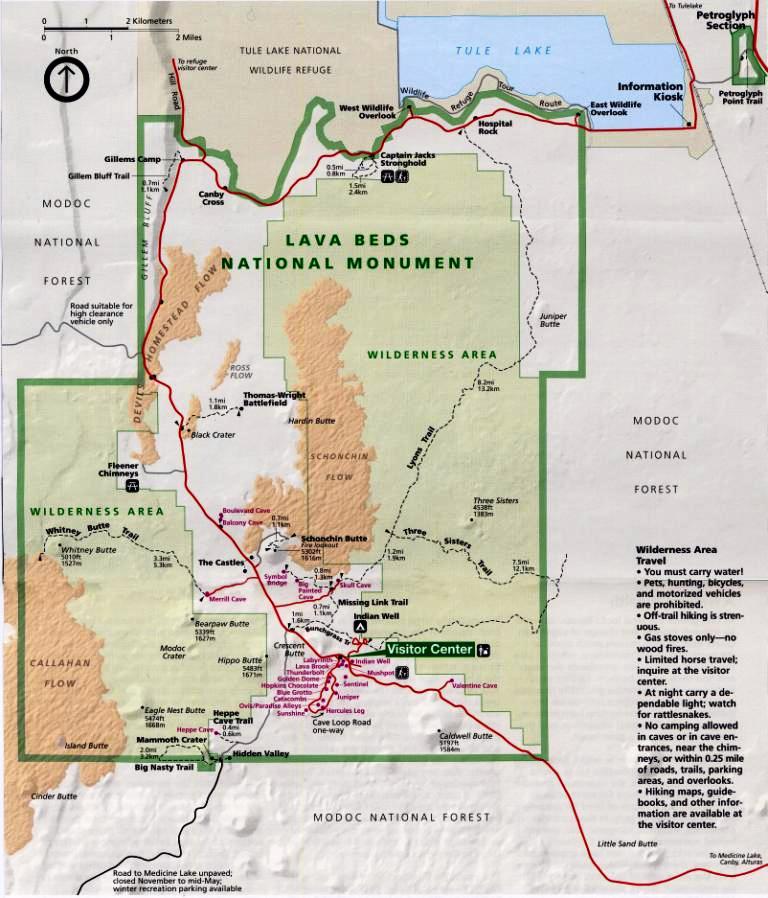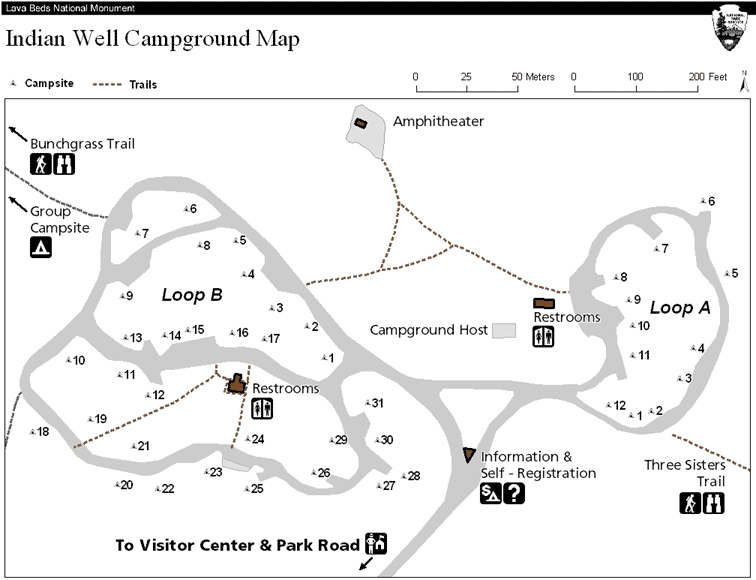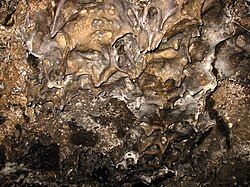Lava Beds National Monument Reviews
Photo of Lava Beds National Monument view of the Medicine Lake Volcano
from Captain Jack's Stronghold.
Here is a detailed Lava Beds National Monument Reviews.
Lava Beds National Monument is located in Siskiyou and Modoc Counties of northeastern California. The nearest major city to Lava Beds National Monument is Klamath Falls, Oregon. It is located in the northeastern end of the Medicine Lake Volcano in Cascade Range that has the largest total area covered by a volcano.
The region in and around Lava Beds Monument is unique because it lies on the junction of the Sierra-Klamath, Cascade, and the Great Basin physiographic provinces. The Lava Beds National Monument covers a area of over 46,000 acres (190 km2) that was established as a United States National Monument on November 21, 1925.
The Lava Beds National Monument has twenty five having marked entrances Lava tube caves with and developed trails for public access and exploration. The Lava Beds Monument also has trails through the high Great Basin xeric shrubland desert landscape and the volcanic fields.
Lava Beds National Monument Maps
Here is the map of Lava Beds National Monument. It belongs to US National Parks. You need to purchase a National Park daily entrance or purchase a US National Park Pass to enter this volcanic wonder. Here is the map of Lava Beds National Monuments.

The major attraction of this park is visiting 25 under ground lava caves. It is shown above near the visitors center in pink. Here is the self guided lava tubes cave loop drive with the entrance of the cave marked. Caves of Cave Loop is close to the Visitor Center at the south end of the park. You are required a flash light and hard hat to enter the cave at all times because it is very dark and cave celings have corns that can easily damage your head. It is recommend but not required to have a nee pad in case you trip while walking inside the cave. Have plently of time visiting the caves because it will take your breath away. There are various caves from very narrow to very large that even contains ice during the heat of the summer (100F outside temperator). Caves can be very cold so it is advice to carry a sweater.
For accormadation we recommend camp in the campgrounds near the cave loop.

Goods & Services inside Lava Beds National Monument
The bookstore in the Visitor Center provides snack food, ice, flashlights both for loan and purchase, caving helmets, film, batteries, books, and an assortment of souvenirs.
No gas, firewood, restaurants, or showers are available in the park, but can be found in the nearby communities of Tionesta, CA; Tulelake, CA; and Merrill, OR (20-30 minutes from the Visitor Center area)
Lava Beds National Monument Geologic Formations
Medicine Lake Shield volcanic eruptions have created an incredibly rugged landscape teaming with many geologic formations. Lava Beds National Monument has outstanding geologically variety of "textbook" volcanic formations of lava tube caves, fumaroles, cinder cones, spatter cones, pit craters, hornitos, maars, lava flows, and volcanic fields
Lava Tube Caves in Lava Beds National Monument

Photo of Lava Beds National Monument's Illuminated Lava tube cave where
lava cicles on the ceiling of Mushpot Cave.
About 30,000-40,000 years ago, Lava flows formed most of the lava tube caves in the monument. When the hot basaltic lava flowed downhill, its' top cooled and crusted over, insulating the rest of the lava and forming lava tubes. Lava cicles on the ceiling of a lava tube were left as the level of lava in the tube retreated and the viscous lava on the ceiling dripped as it cooled.
Dripstone was created when lava splashed on the inside walls of the tubes. The leaching of minerals from pumice gravel, soils, and overlying rock provides for deposition of secondary speleothems in lava tubes.
Lava Beds National Monument has the largest concentration of lava tube caves in North America. One has electrical lighting, the others are illuminated by ceiling collapse portals or require flashlights, available to loan.
Lava flows in Lava Beds National Monument
Photo of a Lava cicles on the ceiling of Mushpot Cave.
Roughly ninety percent of the lava in the Lava Beds Monument is basaltic. There are primarily two kinds of basaltic lava flows: pahoehoe and 'A'a. Pahoehoe is smooth and ropy and is the type most common in Lava Beds. Aa is formed when pahoehoe cools and loses some of its gases. Aa is rough, sharp, and jagged; an excellent example is the Devils Homestead lava flow, which originated at Fleener Chimneys. Most of the rest of the lava in the monument is andesitic. Pumice, a type of rhyolitic lava, also is found covering the monument; this rained down around 900 years ago during the eruption of Glass Mountain.
The flows from Mammoth and Modoc Craters comprise about 2/3 of the lava in the monument. Over 30 separate lava flows located in the park range in age from 2,000,000 years BP to 1,110 years BP. Some of the major Lava Flows within Lava Beds National Monument are Callahan Flow, Schonchin Flow, Mammoth Crater Flow, Modoc Crater Flow, and Devils Homestead Flow.
Cinder Cones in Lava Beds National Monument
Magma is under great pressure Cinder cones are formed when it is released in a fountain of lava and blown into the air from a central vent. Lava cools as it falls, forming cinders that pile up around the vent. When the pressure has been reduced, the rest of the lava flows from the base of the cone. Cinder cones typically only erupt once.
Visit Cinder cones of Hippo Butte, Three Sisters, Juniper Butte, and Crescent Butte are all older than the Mammoth and Modoc Crater flows, more than 30,000-40,000 years old. Cinder connes of Eagle Nest Butte and Bearpaw Butte are 114,000 years old. Formed around 62,000 years ago is Schonchin Butte cinder cone. Valentine Cave erupted 10,850 years ago. An eruption that formed The Castles is younger than the Mammoth Crater flows. Even younger were eruptions from Fleener Chimneys, such as the Devils Homestead flow, 10,500 years ago, and Black Crater 3,025 years ago. Eruption from Cinder Butte aAbout1,110 years ago, plus or minus 60 years, the Callahan flow was produced. Though Cinder Butte is just outside the boundary of the monument, the Callahan flow is in Lava Beds and is the youngest flow in the monument.
Spatter cones are built out of thicker lava. The lava is thrown out of the vent and builds, layer by layer, a chimney surrounding the vent. Fleener Chimneys and Black Crater are examples of spatter cones.
Lava Fields in Lava Beds National Monument
Gillem Bluff, a fault scarp, was created as the region stretched and a block of earth dropped down along this fault (see Basin and Range Province). The tuff layer on top of Gillem Bluff is 2,000,000 years old, inferring the rock layers beneath are even older. The oldest lava flow from the Medicine Lake Volcano within the monument is the Basalt of Hovey Point, near Captain Jack's Stronghold, which is 450,000 years old. Petroglyph Point was created about 275,000 years ago when cinders erupted through the shallow water of Tule Lake; violent explosions of ash and steam formed layers upon layers of tuff.
The caldera itself is thought to have formed by subsidence, during which basalt and andesite were erupted up on the slopes.
Recent Activity in in Lava Beds National Monument
A series of small earthquakes in late 1988 has been attributed to subsidence
in the caldera. N-NE trending ground cracks, as well as N-NE trending
vent series show relationships between tectonism and volcanism. One very
prevalent ground crack exists along the northeastern boundary of the monument-
"The Big Crack."
Climate in in Lava Beds National Monument
Lava Beds Monument receives an average of 15 inches (380 mm) of annual precipitation in the high elevations of semi-arid desert environment. Climate is warm, dry summers and cold winters. Average annual high temperature is 60 °F (16 °C) and average annual low temperature is 35 °F (2 °C). Temperature extremes range from 18 °F (-8 °C) to 102 °F (39 °C). Average annual snowfall is 44 inches (110 cm). It is recommend to visit Lava Beds National Monument during the summer from end of May to end of July when the temperatures are not high as 100 °F where comforably camped in near the cave loop. However, in August where temperatures can reach over 100 °F makes it uncomfortable in the daytime. Check the weather forcast for Tulelake, CA.
Lava Beds National Monument Flora and Fauna
Flora in Lava Beds National Monument
The lava tube collapse systems and lava outcrops support a great diversity
of plant life, from an impressive variety of lichens and mosses to plants
such as Desert Sweet (Chamaebatiaria millefolium) and the aromatic purple
Desert Sage (Salvia dorrii carnosa). An impressive variety of fern species
are present in cave entrances including the spreading Wood Fern (Dryopteris
expansa) and the Western Swordfern (Polystichum munitum). These species
are well outside of their normal range which is 90–125 miles (140–201
km) west on the northern California coastline.
Fauna in Lava Beds National Monument
A false-color satellite image of Lava Beds National Monument and the surrounding area (more information).
Despite harsh, semi-arid conditions, native wildlife has adapted to the environmental constraints present in the region. There are no terrestrial water resources in Lava Beds National Monument. Some animals obtain water from caves, while others fly about twenty km (12 miles) north to Tule Lake. Federal and state animal species of special concern in the Monument include: Cooper's Hawk (Accipiter cooperii), Fringed Myotis (Myotis thysanodes), Long-eared Myotis (Myotis evotic), Long-legged Myotis (Myotis volans), Pallid Bat (Antrozous pallidus), Silver-haired Bat (Lasionycteris noctivigans), Townsends Big-eared Bat (Corynorhinus townsendii), Western Small-footed Myotis (Myotis ciliolabrum), and American Badger (Taxidea taxus).
Because of a lack of surface water, amphibian presence in the monument is limited. The most common species found in the monument is the Pacific tree frog (Pseudacris regilla). This species is also found in the biologically rich cave entrances in the monument. Reptile species found in the monument include: northern sagebrush lizard (Sceloporus graciosus graciosus), Great Basin fence lizard (Sceloporus occidentalis biseriatus), western skink (Eumeces skiltonianus skiltonianus), Rocky Mountain rubber boa (Charina bottae utahensis), gopher snake (Pituophis melanoleucus), desert night snake (Hypsiglena torquata deserticola), western rattlesnake (Crotalus viridis).
Key Lava Beds National Monument Animal Species by Habitat:
Lava Beds National Monument contain various butterflies. Here is a check sheet of butterflies to observe.
Bunch grass-sagebrush grasslands: mule deer, coyote gopher snake, Prairie
Falcon, Western Meadowlark, Anderson's larkspur, yellow-bellied marmot,
Kangaroo Rat
Ponderosa-juniper-brushlands: Pronghorn Antelope, Bobcat, Scrub Jay, Jackrabbit,
Mountain Bluebird,
pine forest: Mountain Lion, Bald Eagle (winter resident), golden-mantled
ground squirrel
Rocky Lava Flows: western fence lizard, western rattlesnake
Cave mouths & interior passages: Violet-green Swallow, Brazilian Free-tailed
Bat, Townsend's big-eared bat, Pacific tree frog, Pika, Bushy-tailed Woodrat
Lake shore areas: Skunk, Raccoon, Great Horned Owl, Short-eared Owl.
Lava Beds National Monument History
Archeological site
Lava Beds National Monument includes Petroglyph Point, one of the largest panels of Native American rock art in the United States. The region is the of the Modoc people. The Lava Beds National Monument Archeological District was listed on the National Register of Historic Places in March 1991.
Modoc War

Captain Jack's Stronghold.
During the Modoc War of 1872-1873, the Modoc Indians used these tortuous
lava flows of their homeland to defend their territory. Under the leadership
of Native American Captain Jack, the Modocs took refuge in "Captain
Jack's Stronghold", a natural lava fortress. From this base a group
of 53 fighting men and their families held off US Army forces, that numbered
up to ten times the Modocs' population, for five months. Gen E. R. S.
Canby was killed here in April 1873 by Captain Jack at a meeting attempting
to negotiate peace terms.
Lava Beds Wilderness Area
The Lava Beds National Wilderness Area is a 28,460-acre (11,520 ha) wilderness area within the Lava Beds National Monument. It was designated by the US Congress on October 13, 1972 with passage of Public Law 92-493. The wilderness protects more than half of the national monument in two separate eastern and western units. The larger eastern unit contains the extensive Schonchin lava flow on the east side of the monument. The western unit covers the monument's area within the transition zone of the Cascade Range's montaine southern end and the arid Modoc Plateau ecosystems.
The different soil types creates plant community diversity in the Wilderness Area, providing various habitats for a wide range of wildlife. The numerous coyotes and foxes, as well as raptors feed on rodents such as the jackrabbit and kangaroo rat. The kangaroo rat here is especially adapted to dry, waterless environments because it can go 'a lifetime' without water. A metabolic process occurs where water is synthesized from chemical components in the dry seeds that the rat eats.
Many of the birds seen the Wilderness Area are raptors, with 24 species of hawks identified. The monument is located on the Pacific Flyway and the Bald eagle winters here in the northern portion of the Wilderness Area. The National Park Service manages the Lava Beds Wilderness Area and has several restrictions in place, such as camping prohibited near cave entrances or trails. Open campfires may be prohibited during very hot and dry weather.
We have provided detailed Lava Beds National Monument Review with our experience of visiting this Lava Tubes park. Visit here for more National Parks of California.
| National Parks of California | |||||||||||||||||||||||||
|---|---|---|---|---|---|---|---|---|---|---|---|---|---|---|---|---|---|---|---|---|---|---|---|---|---|
|
|||||||||||||||||||||||||
Camping Resources
Free Services
Free Text MessagesFree Picture Messages
Free Fax
Free Calls
 CampingCalifornia.org
CampingCalifornia.org
